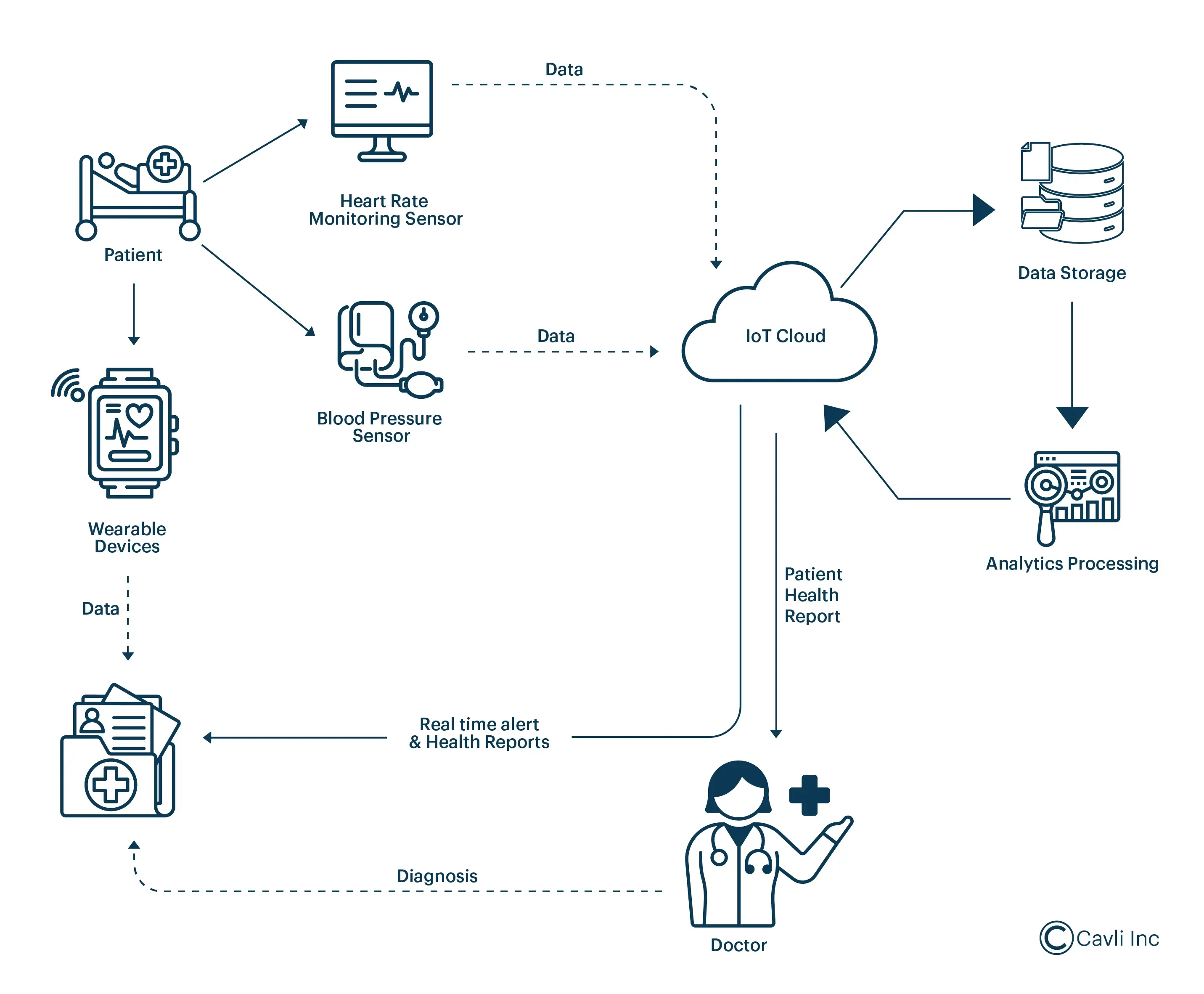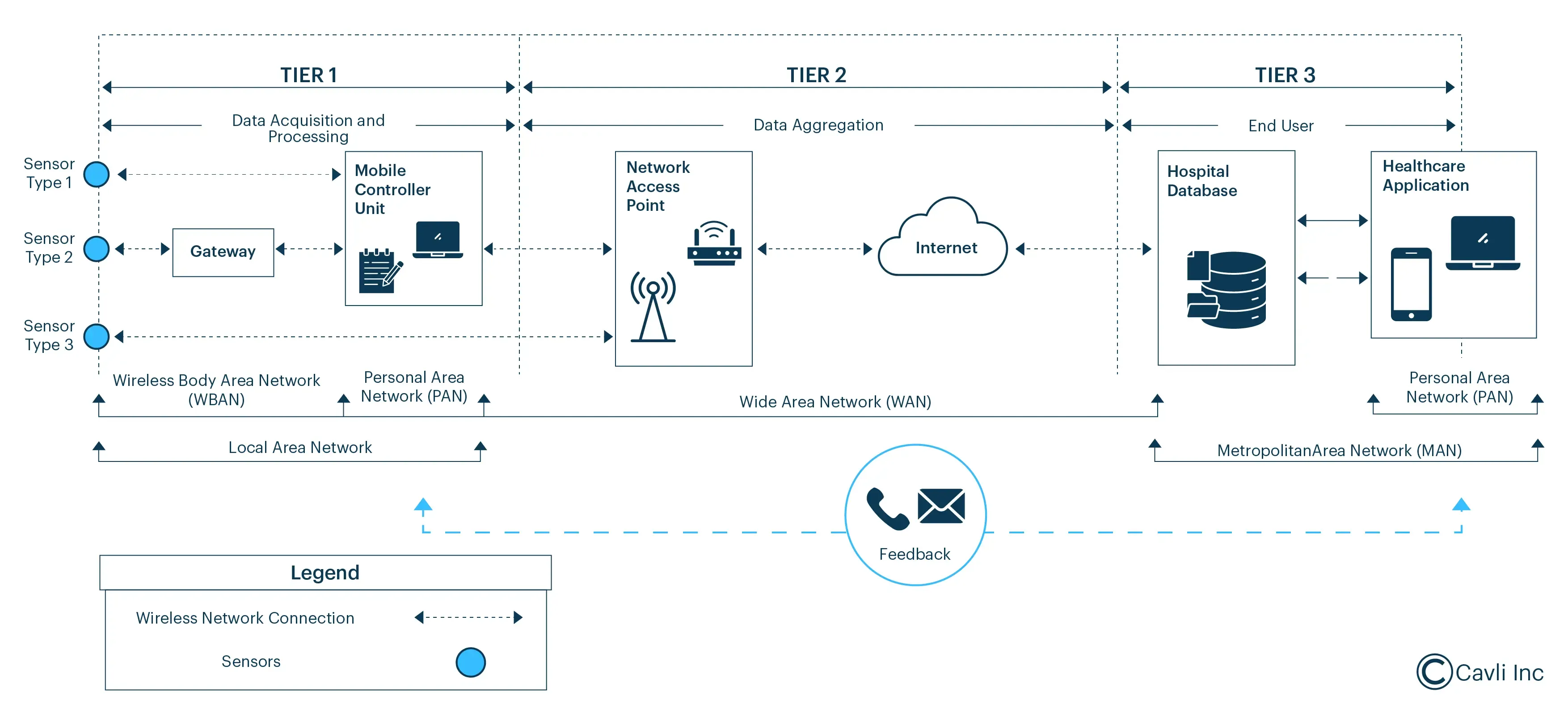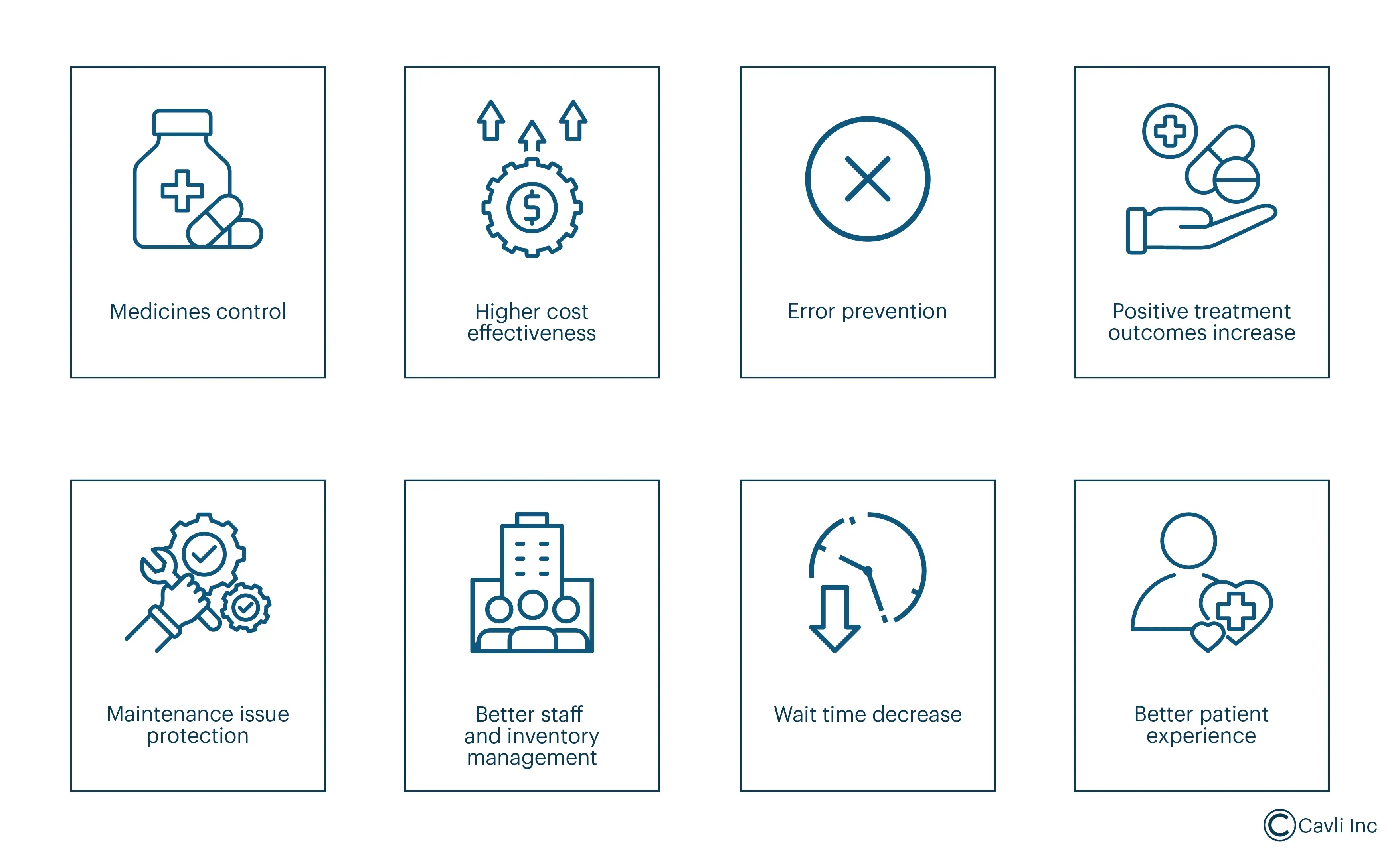How IoT in Healthcare is Revolutionizing Medical Innovations and Patient Care
What power do you think has the Internet of Things instilled in modern connected healthcare?
IoT in healthcare is transforming the medical industry, enabling remote patient monitoring, IoT medical devices, and personalized care. These advancements are making healthcare smarter, more efficient, and more accessible than ever before.
You can experience this in each sector and the Healthcare sector is not different.
Over the years the healthcare sector has transformed with the introduction of IoT and now we are witnessing the unbelievable like robotic surgeries, patient monitoring and smart pills and more.
Understanding IoT in Healthcare: Connecting Medical Equipment and Enhancing Patient Monitoring
The father of Modern Science, Sir William Osler quotes “Medicine is a science of uncertainty and an art of probability."
The role of IoT in healthcare has been revolutionary, improving patient care through IoT medical devices like smart wearables, remote monitoring devices, and connected diagnostics tools. These devices provide real-time data, enabling better patient outcomes and personalized treatment plans.
IoT devices can mitigate uncertainty that often arises from not having enough data or not having it in real-time. It enables a comprehensive view of a patient's health status, reducing the uncertainty in diagnosis and monitoring.
On the probabilistic side, IoT enables the aggregation and analysis of large datasets that can be used to model health outcomes more accurately. With advanced analytics and machine learning, these data can help predict patient outcomes, and personalize treatment plans.
The IoT medical devices and systems are pivotal in transforming healthcare settings making healthcare delivery more personalized and proactive. As we advance through this topic, let's understand the significant improvements around medical equipment, remote patient monitoring and care management and more from the IoT healthcare industry.
According to Mordor Intelligence, the IoT in healthcare market is expected to grow from USD 147.44 billion in 2024 to USD 348.03 billion by 2029, with a CAGR of 18.74%. This growth highlights the increasing demand for IoT medical devices and connected healthcare solutions.
From Digital Diagnostics to Smart IoT Medical Devices: The Importance of IoT in Healthcare
Imagine this, you are attending a business conclave away from your hometown. But suddenly you become ill and your health monitor flashes low blood pressure levels.
In conventional cases, you would have to get help to find a local doctor, try to explain your symptoms and get the necessary medical service, which can be time consuming at times. Now, with the advancements in technology, you can check your health monitoring data and remotely consult your doctor over the telephone, to get a timely medical intervention.
In the healthcare sector, the importance of IoT is profound due to its ability to enhance patient monitoring, quality of care, and operational efficiency. The integration of the Internet of Things in healthcare is revolutionizing patient care and medical services by enhancing the intelligence of critical devices. IoT in healthcare is important as
- IoT technology can be incorporated in various healthcare applications, including remote patient monitoring, smart wearables, and advanced diagnostics.
- These intelligent devices collect real-time data on vital signs, patient activity, and environmental factors, transmitting this information to healthcare providers for timely interventions.
- The continuous monitoring and data analysis facilitated by IoT devices allow for early detection of potential health issues, improving the accuracy of diagnostics, preventing complications and improving treatment efficiency.
The Precedence Research states that the global IoT medical devices market size, at 63.88 billion in 2023, is expected to reach around USD 815.21 billion by 2033, showcasing a CAGR of 29%.
Personalized Healthcare Powered by IoT: Enhancing Patient Care and Treatment

A modern-era connected healthcare system is depicted here.
IoT also plays a crucial role in personalized medicine. By leveraging data collected from IoT medical devices, healthcare providers can tailor treatment plans to the individual needs of patients, thereby increasing the effectiveness of interventions.
For example, patients with chronic conditions can receive continuous assistance outside traditional clinical settings, improving patient management and reducing the need for hospital visits. This level of customization is particularly valuable in managing complex conditions where standardized treatments may not be optimal. This connectivity not only enhances patient monitoring but also streamlines hospital operations, reduces costs, and supports personalized medicine.
Moreover, IoT technologies help streamline healthcare operations by automating routine tasks, such as patient data collection and analysis. This not only reduces the burden on healthcare staff but also minimizes the potential for human error, leading to better resource management and more accurate healthcare delivery.
IoT in Healthcare: Optimizing Resources and Performance for Improved Healthcare Management
The Internet of Things (IoT) is transforming healthcare, optimizing resources, improving patient monitoring, and enhancing operational efficiency. By integrating smart devices and connectivity, IoT applications in healthcare are paving the way for innovative solutions across hospitals, clinics, and home care settings. This article explores how IoT is revolutionizing the healthcare sector through real-world applications and success stories.
IoT in Different Healthcare Settings
Hospitals: Leveraging IoT for Smarter Patient Management
In hospital settings, IoT is widely utilized to enhance patient care, streamline workflows, and enable precise monitoring. Smart beds, real-time monitoring systems, and IoT-enabled devices are some of the key applications transforming hospital operations.
- Smart Beds for Patient Safety and Comfort
Hospitals are leveraging IoT in healthcare to improve patient comfort and safety through smart beds. These beds are equipped with IoT sensors that monitor patients’ vital signs, movements, and posture, automatically adjusting to enhance comfort and reduce risks like bedsores and patient falls. This has led to significant improvements in patient care and hospital efficiency. - Real-Time Monitoring for Better Patient Outcomes
Many hospitals are implementing IoT-enabled patient monitoring systems to track vital signs like heart rate, blood pressure, and oxygen levels. By utilizing IoT in healthcare, medical staff receive real-time alerts on critical changes, enabling timely interventions. This has led to reduced hospital readmission rates and enhanced patient safety, making it a cornerstone of smart hospital operations.
Clinics: Enhancing Patient Engagement and Diagnostic Accuracy
IoT in clinics improves diagnostic accuracy, enhances patient engagement, and streamlines workflows. Clinics use IoT-enabled diagnostic tools, telemedicine systems, and wearable devices to provide comprehensive care.
- IoT-Enabled Telemedicine for Remote Patient Management
Clinics are increasingly adopting IoT-based telemedicine solutions to manage chronic diseases more effectively. Patients equipped with IoT-enabled wearables can transmit health metrics like blood glucose levels and blood pressure in real time. This application of IoT in healthcare allows clinicians to monitor patient conditions remotely and offer personalized care plans, resulting in improved patient adherence and engagement.
Home Care: IoT Applications for Remote Monitoring and Independent Living
The use of IoT in healthcare has expanded to home care settings, where it plays a crucial role in enabling remote monitoring of patients with chronic conditions and supporting independent living for elderly patients.
- Remote Monitoring for Chronic Conditions and Elderly Care
IoT-based remote monitoring systems are widely adopted to track patients’ vital signs and health metrics continuously. These systems utilize IoT wearables and sensors to provide real-time insights into patients’ conditions, ensuring prompt interventions when necessary. This approach has proven effective in reducing hospital readmissions, improving patient outcomes, and allowing patients to live independently longer.
How does IoT Technology Work in Healthcare Processes?
The integration of the Internet of Things in healthcare processes involves several key steps. The key steps are discussed below:

IoT Health Monitoring - Data Flow Structure
Data Collection:
IoT medical devices collect comprehensive health data from patients by monitoring them around-the-clock.
Data Transmission:
This data is securely transmitted through secure gateways to healthcare systems for thorough analysis.
Data Analysis:
Healthcare professionals analyze the processed data, gaining insights into patient health, thereby streamlining treatment efficacy.
Actionable Insights:
Healthcare providers make data-driven decisions and adjust medical treatments in real-time.
Smart Pills to Robo-Docs: IoT Applications and Use Cases in Healthcare

Benefits of IoT in Healthcare
The Internet of Things (IoT) in healthcare involves various connected devices and systems that collect, transmit, and analyze health data in real-time. Let’s explore key IoT applications revolutionizing healthcare:
Telemedicine: Revolutionizing Remote Healthcare Delivery
IoT is transforming telemedicine by enabling real-time data transmission, remote monitoring, and personalized care.
Remote Patient Monitoring for Enhanced Telemedicine Services
Telemedicine solutions powered by IoT in healthcare enable real-time monitoring of patients' health conditions. IoT-connected devices collect and transmit vital signs, such as heart rate and oxygen levels, to healthcare providers. This allows doctors to offer timely consultations and personalized treatment plans, significantly improving healthcare accessibility and patient outcomes.Chatbots in IoT Healthcare for Patient Support
IoT-powered chatbots play an important role in patient support by utilizing connected devices to analyze real-time data and offer personalized assistance.
Chatbots for Enhanced Patient Engagement
IoT-based chatbots utilize patient data to track symptoms, offer reminders, and provide real-time medical advice. By connecting with IoT-enabled health devices, these chatbots improve patient engagement and deliver 24/7 support, easing the workload of healthcare providers.Smart Wearables: Continuous Health Monitoring for Proactive Care
Smart wearables in IoT healthcare applications continuously monitor critical health metrics, empowering patients and healthcare providers to make informed decisions.
Wearables for Heart Rate and Blood Sugar Monitoring
IoT-enabled wearables like smartwatches monitor vital signs such as heart rate, blood glucose levels, and sleep patterns. These devices not only provide real-time insights but also detect anomalies, prompting further investigation or emergency interventions. The use of IoT in healthcare wearables is improving chronic disease management and enhancing proactive care.Remote Patient Monitoring: Transforming Care with IoT Wearables
IoT wearables and smart sensors are critical for remote patient monitoring, allowing healthcare providers to access real-time patient data and respond to health concerns promptly.
IoT-Integrated Remote Monitoring Systems
Remote patient monitoring systems powered by IoT continuously track key health parameters, such as blood pressure, heart rate, and glucose levels. By integrating IoT technology with Electronic Health Records (EHR) systems, healthcare providers have immediate access to patient data, improving timely interventions and reducing emergency hospital visits.Smart Medical Devices for Enhanced Accuracy and Adherence
IoT-based smart medical devices play a key role in improving patient care through accurate data tracking and personalized treatments.
Connected Inhalers for Respiratory Health Management
Smart inhalers equipped with IoT technology track medication usage and monitor environmental factors like air quality. By connecting with healthcare providers, these devices ensure precise medication delivery and improve treatment adherence, reducing asthma attacks and enhancing patient safety.Inventory Management: Optimizing Resources with IoT in Healthcare
Effective inventory management is vital for healthcare efficiency, and IoT solutions are transforming this critical area.
IoT-Powered Smart Inventory Systems
Healthcare facilities are utilizing IoT-based inventory management systems to track supplies, equipment, and medications in real-time. IoT sensors and RFID tags enable accurate monitoring of inventory levels, reducing waste, avoiding stockouts, and improving resource allocation.Robotic Surgery: Enhancing Precision with IoT Technology
IoT-based robotic surgery systems are revolutionizing surgical procedures by enhancing precision and control.
IoT-Enabled Robotic Surgery for Minimally Invasive Procedures
IoT-powered robotic surgery systems provide surgeons with real-time data and enhanced control, enabling them to perform minimally invasive procedures with greater accuracy. This IoT application in healthcare has reduced patient recovery times and improved surgical outcomes, making it a promising advancement in medical technology.Combating Counterfeit Medicines with IoT Technology
Modern pharmaceutical companies are deploying smart labels embedded with QR codes and holographic watermarks, creating a comprehensive digital shield against counterfeit drugs. These IoT-enabled smart labels contain encrypted data that tracks the complete supply chain journey, from manufacturing facilities to local distributors, recording critical timestamps including production dates, quality control checkpoints, dispatch times, and delivery confirmations. With this integrated IoT ecosystem, pharmaceutical companies can detect counterfeit patterns, monitor global distribution networks, and provide healthcare providers with medical authenticity.
The integration of IoT in healthcare offers numerous benefits, such as improved patient safety, enhanced operational efficiency, and reduced healthcare costs. IoT solutions empower healthcare providers to deliver proactive, personalized care and optimize resource management. The real-time insights gained from IoT devices allow early detection of health issues, minimizing complications and emergency situations.
Download Our Smart Health Monitoring Guide to Explore IoT in Healthcare!
Navigating Through Complex Landscape of IoT in Healthcare: Real-World Challenges Discussed
Final lap challenges faced by IoT in healthcare are:
Privacy and Security
Security remains a major concern with IoT in healthcare. To ensure patient privacy and HIPAA compliance, IoT medical devices must use encryption, secure data transfer protocols, and comply with stringent regulations. As more devices are connected, robust security audits and authentication protocols are essential to protect sensitive health data.
The latest Sophos Annual Study shows that 67% of healthcare organizations were hit by ransomware in 2024, and this almost double reported by the sector in 2021 (34%).
Researchers have demonstrated the ability to hack or Tamper devices like insulin pumps and pacemakers, highlighting the life-threatening potential of compromised medical IoT devices.
Ensuring robust security protocols, including end-to-end encryption, secure device authentication, and regular security audits, are crucial in maintaining IoT security. Additionally, healthcare organizations must comply with stringent regulations like HIPAA in the U.S., which governs the security and privacy of health information.
Integration of Devices and Protocols
Integrating new IoT devices with existing healthcare systems can be complex. The integration of IoT medical devices with existing healthcare systems poses significant technical and logistical challenges. Healthcare environments may be using outdated systems or ones not designed to communicate with new IoT devices. Many hospitals still rely on older equipment requiring costly upgrades or custom solutions. Integrating new IoT solutions requires comprehensive interoperability strategies, involving both hardware and software modifications, which can be costly and time-consuming.
Costs Involved
The cost associated with implementing IoT in the healthcare industry can be a barrier, especially for smaller institutions. The initial expenses in healthcare IoT include not only the purchase of IoT devices but also, its integration with existing systems, training for staff about the new medical devices, and also potentially significant infrastructure upgrades. The ongoing costs include maintenance charges, software updates, and other security charges. However, it's important to consider the long-term savings and improvements in care quality so that IoT solutions can offer reduced hospital stays, decreased need for in-person visits, and improved chronic disease management.
5G Technology in Internet of Medical Things (IoMT)
The future of IoT in healthcare is poised for a transformative shift with the integration of 5G technology. The advancements such as 5G NR, URLLC, eMBB, mMTC, and 5G RedCap (Reduced Capability) are collectively enhancing the Internet of Medical Things (IoMT), enabling unprecedented precision and efficiency in medical practices.
- 5G NR (5G New Radio) facilitates high-speed, low-latency communication crucial for real-time remote surgery and telemedicine, where even millisecond delays can be critical.
- URLLC (Ultra-Reliable Low Latency Communication) ensures reliable connections for autonomous surgical robots to perform precise surgical procedures.
- eMBB (Enhanced Mobile Broadband) supports high-bandwidth applications such as streaming high-definition medical imaging like MRIs and CT scans and analysis of large sets of patient data for diagnostics and research.
- mMTC (massive Machine Type Communication) on the other hand, connects smart hospital infrastructure such as smart beds, infusion pumps, and HVAC systems and also plays a crucial role in inventory management by tracking and managing medical supplies in real-time.
- 5G RedCap has revolutionized the optimized wearable IoT device sector by powering wearable health monitors, portable ECG monitors etc that continuously monitor patients' vitals and transmit data to healthcare providers in real-time.
The Future of IoT in Healthcare
As IoT in healthcare continues to evolve, the integration of 5G technology is set to play a pivotal role in advancing IoT medical devices. With 5G's ultra-low latency and high-speed connectivity, healthcare systems can expect faster, more reliable data transmission. This is especially important for remote surgeries and real-time diagnostics, where even millisecond delays can be critical. 5G will support real-time data streaming from wearables, surgical robots, and diagnostic equipment, enabling healthcare professionals to make immediate, life-saving decisions.
Additionally, AI-powered IoT devices are transforming healthcare by offering predictive analytics that can improve early diagnosis and treatment efficiency. By analyzing large datasets collected from IoT medical devices, AI can detect patterns and anomalies that might be invisible to human practitioners. This will lead to personalized treatment plans, better management of chronic conditions, and early interventions that reduce emergency situations.
The synergy between IoT, 5G, and AI is revolutionizing patient care, making it more proactive and less reactive. Healthcare providers will have access to comprehensive real-time data, not just from individual patients but also from smart hospital systems, ambulatory care, and remote clinics, all interconnected through an intelligent network. This interconnected future of IoT in healthcare promises to create a more efficient, responsive, and personalized healthcare ecosystem.
Closing Notes:
Looking forward, the potential of IoT in the healthcare industry is boundless. Future developments include more sophisticated wearable technologies, deeper integration of AI to analyze health data, and the expansion of IoT applications into even more areas of healthcare. These advancements will continue to drive improvements in healthcare delivery, making care more personalized, accessible, and efficient.
IoT healthcare solutions are revolutionizing how care is delivered, emphasizing its ability to transform patient care through advanced technology and connectivity. As we progress, the integration of IoT within healthcare will significantly enhance the quality of life for patients and streamline operations for healthcare providers, marking a major step forward in the evolution of healthcare.
IoT healthcare solutions are revolutionizing care delivery. Explore how Cavli Wireless IoT modules can enable the next generation of IoT medical devices for healthcare applications, empowering providers with cutting-edge tools to improve patient outcomes.



